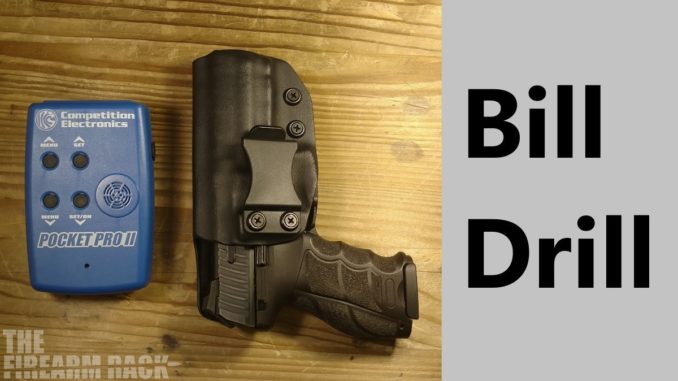
This week’s Pistol Power Drills is a very simple one, the Bill Drill. This is a quick, repeatable drill, that stresses some of the most important fundamentals. This is a fast speed drill and will put your abilities to the test.
How To Shoot The Bill Drill
This might be the easiest to set up drill that we’ve covered so far. At seven yards, begin with gun holstered, loaded with six rounds, and hands in the surrender position. The target used here is a standard IPSC target, and all hits need to be in the “A” zone. On the buzzer, draw, and fire six rounds into the A zone. There isn’t really a par time per se, however, anything under three seconds is quite good.
What Do You Need To Do The Bill Drill?
For the Bill Drill, you are going to need a good holster, a shot timer, and a target. The drill calls for use of an IPSC target, however, you can use whatever target floats your boat. This is an accuracy and speed drill, so you can make the target smaller if you want more challenge. I personally use B8 targets, and only count hits within the black scoring rings as hits. I can only harp on this so much; If you don’t have a shot timer yet, get one! The Pocket Pro II is still quite affordable and makes each practice session easier to quantify.
Why Shoot The Bill Drill
What the Bill Drill does is get you to focus on three things, your draw, sight alignment, and grip. This drill is drawing, then dumping six rounds. It is not complicated, however, if you slack in regards to one of those three things, you are either going to miss or be very slow. Many of the drills discussed this far have stressed quickdraws, as in reality, you need to be fast when getting the gun out. There’s no playing around that.
A big chunk of the Bill Drill is a solid grip on the gun and tracking the front sight. We all know that you can have a sup-par grip on your pistol, and still get an accurate hit, but you sure as hell can’t get five more with bad grip. This is a “good enough” sight picture drill, as we want fast hits, and although accuracy is paramount, we have an acceptable deviation here. As long as the hits can fall within the target area that we’ve set, we can allow for certain, less than optimal firing solutions. Keeping the focus on the front sight so that we can fire as soon as it falls into the rear sight is the name of the game here. The MRDS like a Trijicon RMR also shines here, as tracking the dot, with enough practice, will be faster under recoil than with iron sights.
Cadence is something that I talk about a lot, and the Bill Drill pounds that home. This is about shooting at top speed, and knowing what your seven-yard cadence is. We’ve got speeds for every distance, and we’ve got to know what speed to run at specific distances. You can’t maintain lightning speed (generally) at distance, but you can as you get closer. The Bill Drill is great practice for shooting faster at close distance.
Why Is The Bill Drill Important
Much like our previously covered drills, the Bill Drill is a modern classic. The Bill Drill is named after a Bill, although there is contention as to which Bill. From what I’ve seen, I’d reckon that the Bill behind it is none other than Bill Wilson. This drill is almost as old as the Mozambique, and I’d argue that it is more practical. This is an easy drill to set up and perform and is very repeatable. Those are big pluses in my book.
Get your speed mode on, and give the Bill Drill a try next time that you hit the range!
Affiliate Disclaimer: Firearm Rack is funded through direct donations and affiliate programs. Some links on FirearmRack.com are affiliate links. Using one of these links costs nothing extra, the retailer pays a percentage of the sale to Firearm Rack. Funding in this manner will assure that factual information is always first. If you would like our Amazon affiliate link or find more retailers on the Support Us page









